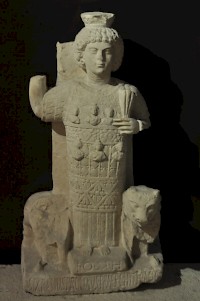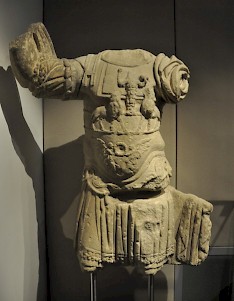Jupiter Heliopolitanus
Jupiter Optimus Maximus Heliopolitanus: Latin name of the supreme god venerated in the great temple of Baalbek.

The greatest temple of Baalbek was dedicated to a god who was, at various periods in history, called Ba'al, Hadad, Helios, Zeus, or Jupiter Optimus Maximus Heliopolitanus. The cult also has several aspects that may or may not have been derived from Egypt.
According to the Roman author Macrobius, the cult statue in Baalbek had been taken from Egypt, was made of gold, and showed the god as a beardless, young man, "with its right hand raised and holding a whip, like a charioteer," while the left hand held "a lightning bolt, and ears of grain".note
We also know that the statue was flanked by two bulls (Hadad's animal), and that the god wore representations of the Sun and Moon on his breast. On his head, he wore a basket-shaped hat, a kalathos. With so many names and attributes, it is fitting that the god of Heliopolis also embodied several qualities: fertility god, lord of thunder and rain, oracular god, supreme deity. He was also a sun god, which may or may not explain the orientation of the temple, more or less on the east.

The temple, the largest in the Roman world, served as an oracle. In 114 CE, the god predicted the emperor Trajan that he would not return from his expedition against the Parthian Empire.note This is one of two known statements by the Baalbek oracle; the other is a decree about several columns, cut for Baalbek but apparently lost at sea near Berytus.note
Macrobius informs us that during a session of the oracle, the statue was placed in a litter; the bearers sort of sensed the divine will and carried it in certain directions, which could be "decoded" by the priestsnote A similar practice is known from the oracle of Ammon in Siwa in Egypt.